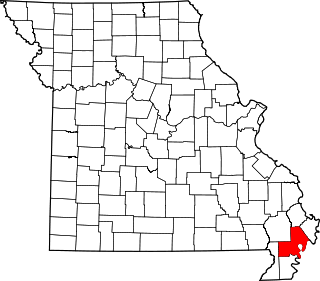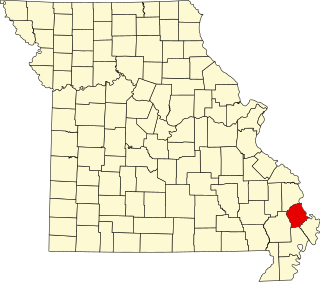
The National Register of Historic Places in the United States is a register including buildings, sites, structures, districts, and objects. The Register automatically includes all National Historic Landmarks as well as all historic areas administered by the U.S. National Park Service. Since its introduction in 1966, more than 90,000 separate listings have been added to the register.

St. Louis Union Station is a National Historic Landmark and former train station in St. Louis, Missouri. At its 1894 opening, the station was the largest in the world that had tracks and passenger service areas all on one level. Traffic peaked at 100,000 people a day in the 1940s. The last Amtrak passenger train left the station in 1978.

This is a list of properties and historic districts in Missouri on the National Register of Historic Places. There are NRHP listings in all of Missouri's 114 counties and the one independent city of St. Louis.

Baton Rouge station is a historic train station located at 100 South River Road in downtown Baton Rouge, Louisiana. It was built for the Yazoo and Mississippi Valley Railroad which got absorbed by the Illinois Central Railroad. The station was a stop on the Y&MV main line between Memphis, Tennessee and New Orleans, Louisiana. The building now houses the Louisiana Art and Science Museum.

The Lick Skillet Railroad Work Station Historic District is a historic district in Brinkley, Arkansas that was listed on the National Register of Historic Places in 1992.

Sanborn Field is an agricultural experiment field, located on the University of Missouri campus in Columbia, Missouri. Established in 1888, it was the first facility in the United States intended to measure erosion and run-off for differing crops and agricultural practices. Work at Sanborn Field was influential in the establishment of soil conservation policy in the United States. The field was designated a National Historic Landmark in 1964.

The following outline is provided as an overview of and topical guide to the U.S. state of Missouri:

Columbia station is a historic train station and headquarters of Columbia Transit located in Columbia, Missouri. The building was constructed in 1909 as the terminus of the Columbia spur of the Wabash Railroad. It is a one-story, H plan, Tudor Revival style building constructed of locally quarried rock faced ashlar cut stone. In 2007, the building underwent renovation and restoration and was expanded to accommodate offices for Columbia's public transportation. The project, costing over $2.5 million, was intended to make the station a multi-model transportation center. It was certified at the LEED Silver Level, meaning it meets national standards for energy efficiency and sustainable construction. The station is the busiest bus stop in Columbia and served as a pickup point for Megabus until September of 2015.

The Missouri State Teachers Association Building is a historic building located at Columbia, Missouri. It was built in 1927 and houses the Missouri State Teachers Association Headquarters. The building is located on South 6th Street on the University of Missouri campus and is a two-story, Tudor Revival style brick building. It was the first building in the United States built specifically to house a state teachers association. A historical marker on the site commemorates the lands former tenant "Columbia College," the forerunner of the University of Missouri.

The Columbia station, also known as Missouri, Kansas, and Texas Railroad Depot or Katy Station, was built in 1909 by the Missouri–Kansas–Texas Railroad in downtown Columbia, Missouri. The station was one of two train stations serving Columbia in the 20th century, the other being the Wabash Railroad Station and Freight House constructed the same year. The building is the terminus of the MKT Trail, a rails-to-trails project that was built on the former spur of the railroad. Having housed a popular local restaurant named "Katy Station" after the building, it now houses a bar name "Shiloh's."

The Moses U. Payne House, also known as Lynn Bluffs and Roby River Bed and Breakfast, is a historic home near the Missouri River in Rocheport, Missouri. It was constructed in 1856–1857, and is a large frame central hall plan I-house. It is five bays wide and features an ornamental ironwork front porch.

This is a list of the National Register of Historic Places listings in Clark County, Missouri.

The Kansas City Police Station Number 4 in Kansas City, Missouri, was built in 1916. It was listed on the National Register of Historic Places in 2005.

This is a list of the National Register of Historic Places listings in Mississippi County, Missouri.

This is a list of the National Register of Historic Places listings in New Madrid County, Missouri.

This is a list of the National Register of Historic Places listings in Pemiscot County, Missouri.

This is a list of the National Register of Historic Places listings in Scott County, Missouri.

The Glenwood Archeological District is a nationally recognized historic district and archaeological sites located in the vicinity of Glenwood, Iowa, United States. It is one of nine sites from the Nebraska Phase of the Woodland period recognized by archaeologists, and the only one located east of the Missouri River. The district is made up of earth lodge sites, mortuary sites and artifact scatters from the Glenwood culture. They date from sometime between 1250 and 1400 C.E. The district was listed on the National Register of Historic Places in 2013.

Hannibal Old Police Station and Jail, also known a City Hall, is a historic police station and jail located at Hannibal, Marion County, Missouri. It was built in 1878–1879, and is a two-story, eclectic late Victorian style brick building on a granite foundation. It features two octagonal towers of different heights and a complex roof defined by a heavy bracketed cornice.

Central Park Historic District is a national historic district located at Hannibal, Marion County, Missouri. The district encompasses 261 contributing buildings, 1 contributing site, and 4 contributing structures in a predominantly residential section of Hannibal. It developed between about 1840 and 1939, and includes representative examples of Romanesque Revival, Late Victorian, and Art Deco architecture. Located in the district are the separately listed Federal Building, Hannibal Old Police Station and Jail, and Eighth and Center Streets Baptist Church. Other notable contributing resources include Central Park with a war memorial monument and a life-size bronze statue of William Henry Hatch (1833-1894), City Hall (1909), old Missouri Guaranty Building (1894), Price Apartments (1904), YMCA (1910), Masonic Temple (1882), Park Methodist Church, Retards Row (1855), Elks Building (1925), Holmes Building, Security Building (1912), Kerchival-Iakenan-Lathrop House, Admiral Coontz Birthplace, Inmaculate Conception Chapel (1854), Episcopalian Trinity Church (1860), and William C. Henn House (1937).
























